*Paul Moore
Fonte: International Mining
There has been a lot of very general talk of a “new normal” in mining, of new ways of mines doing things during the COVID-19 pandemic – a lot of it focussed mainly on a perceived new introduction or speeding up of autonomous operations and without much detail. To get to the bottom of what it actually represents on the ground and look at what any new normal means beyond just the buzzword, IM Editorial Director Paul Moore spoke to five of the world’s leading mining groups: Newmont, Rio Tinto, Barrick, Anglo American and Vale – who together cover a good mix of commodities, regions and surface and underground operations, so can be seen as ‘representative’ of industry best practice. Alongside this, it was important to include some input from METS companies on how they are conducting business in these unique times.
First off, it is clear mining has had to change its procedures very quickly and very significantly – with the majority of change, as would be expected, focussed on immediate steps to ensure worker safety and minimise the risk of the virus spreading. All of the companies agreed that this has been their absolute top priority. In general, these measures include temperature testing on arrival at site, adjusted fly in fly out (or other worker to-and-from site transport) rotas, social distancing in operational and non-operational mine areas, more regular disinfection of shared areas and manned machines, regular testing for COVID, and making sure all contractors (those still allowed on site) are compliant with new setups.
The new normal is mainly procedural
Looking at the detail, all these general measures include a huge number of practical steps that mines have had to take. And the effect of the virus on day-to-day workforce procedures extends to a whole host of other things , particularly in the arena of how to manage suspected cases and testing, as in a sense many mines are isolated communities that are having to act like a small town or city in terms of virus management.
Grant Beringer, Barrick Group Sustainability Executive, told IM: “Self-assessment forms are filled in by employees and contractors prior to being given site access to establish if they have symptoms; have been in contact with someone with symptoms; have been in contact with anyone who has tested positive; or have cared for someone who has tested positive. Barrick’s air travel has been significantly curtailed since the spread of the virus and we have instituted travel forms for all employees and contractors who need to travel to one of our sites from another region or country. This has enabled us to make sure that high-risk individuals and those who we believe may be infected do not travel. Isolation centres for suspected cases have been established at each of our sites and within the communities surrounding our mines.”
Barrick has also been procuring and supplying rapid diagnostic test (RDT) kits to its sites and to community clinics for the early detection of the antibodies caused by the virus. The company explained: “The screening test is carried out in compliance with the protocol developed by our on-site doctors. The final confirmatory test is the quantitative real time reverse transcription–polymerase chain reaction (real time RT-PCR) test performed by a certified laboratory or government authority. When a worker is not feeling well or has been in contact with an infected person, contact tracing helps us identify all persons who may have been in contact with that worker and we have them self-isolate and undergo testing.”
On cleaning, Beringer added that more handwashing stations have been established in and around its sites and communities. Infectious disease sanitation and cleaning practices have also been introduced at all its properties and facilities. Common areas are cleaned more frequently and Barrick has implemented a cleaning protocol to disinfect all vehicles and mining equipment before these are used or passed on to another worker during shift changes.
Rio Tinto of course took the additional step of dedicating some of its lab capacity to actually manufacturing hand sanitiser at various sites, including the Rio Tinto Iron & Titanium Technology Centre in Quebec and, in Australasia, at the Bell Bay site in Tasmania, the Yarwun refinery near Gladstone, Queensland and the New Zealand Aluminium Smelter (NZAS) at Tiwai Point.
The company also makes the point that the types of responses can differ by country depending on the stage the COVID-19 virus is at in terms of infection levels: “Appropriate measures are in place across all our operations to ensure we can respond to the local health situation and comply with local government requirements. It is also important to note that we operate in 36 countries and each is at a different stage in its response to the virus. For example, our Chinese teams were the first to lockdown, but they have now mainly returned to normal.”
COVID communication
Another aspect not often mentioned is education of employees and keeping them abreast of new developments as understanding of the pandemic grows, again as many may not have access to regular media updates.
Beringer said: “Our senior leaders issue communication bulletins regularly so that our personnel maintain a high level of awareness and self-discipline with respect to personal hygiene, social distancing and reporting of potential cases. These bulletins are reviewed with all workers during pre-shift meetings to keep everybody well-informed. On a daily and weekly basis, the respective executives for our three operational regions provide a detailed report on the status of the virus and updates on new cases there and summarise country-level controls that the operations need to be aware of. Proactive reporting and communication across the entire business ensures a holistic approach to the effective management of COVID-19.”
Dual focus
In Brazil, Vale has focused on prevention, as well as detection.
The company told IM: “In addition to establishing a remote work scheme on March 16 for direct and third-party employees in roles that are eligible for home office, the company has focused on maintaining minimum staff at its operational sites to keep its essential activities in a safe manner. All direct and third-party employees are also being tested for COVID-19 and workers who are at risk of developing the severe form of the disease (those aged 60 or over with pre-existing health conditions) were advised to stay at home.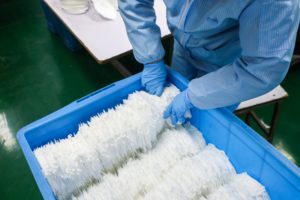
“We have installed 86 thermal cameras in the company’s operational sites in four states (Minas Gerais, Pará, Espírito Santo, and Maranhão) to screen for elevated body temperature; with daily body temperature screening upon arrival at work and application of health questionnaires for the entire staff. Employees with any flu-like symptom are advised to stay at home for 14 days and only essential suppliers have access to the front gates, and we have shut down all non-essential construction work sites. We have put in place technology for screening and are quarantining those who have had contact with people suspected to have COVID-19.”
Vale has also expanded its bus fleet to reduce crowds and ensure safe distancing between people. “Vehicles are operating with open air ventilation, and daily cleaning has been reinforced with disinfectants and rigorous inspection,” the company said. “There have also been shift changes with new start/end times to avoid crowded environments. In restaurants, Vale has adopted measures to increase social distancing by marking seats, reinforcing the cleaning of tables, and distributing lunch boxes and disposable cutlery to avoid possible sources of contamination in utensils. And, with many employees now working remotely from home instead of at a worksite, we were able to close several administrative buildings and limit crowded environments, also making it easier for cleaning teams to move around; cleaning and disinfection protocols comply with technical recommendations. Finally, as recommended by the Ministry of Health, Vale distributed fabric masks to all employees in all the company’s operations in Brazil.”
Newmont added that all of its self-serve food options have been stopped, with deep cleaning of the cafeteria before and after meals. Its vehicles have a maximum capacity of two people that must be seated diagonally from one another. It is also using thermal cameras at entrances to site while on-site gyms have been closed.
Newmont also requires strict physical distancing including the suspension of large indoor gatherings and has significantly increased the number of hand washing and hand sanitising stations across all of its sites along with the provision of masks. The company has also implemented flexible and remote working plans for employees and cancelled all non-essential travel, plus restricted site entry to business-critical visits, essential deliveries and critical contract workers. Mandatory self-quarantine is also required for anyone who has travelled internationally, has flu-like symptoms or who has had direct contact with any person known to have COVID-19.
Anglo American says it is screening tens of thousands of employees and contractors every day as part of a comprehensive global health and wellbeing program that it has put in place – called WeCare – that encompasses physical health, mental health, living with dignity (gender-based and domestic violence), and community response.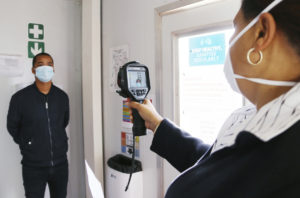
“With respect to testing, Anglo American is building up our own comprehensive COVID-19 Polymerase Chain Reaction (PCR) testing laboratory capability across all our operating sites. Our laboratories are used to analyse tests from employees and contractors and, based on capacity, will also be supporting local community testing. Our strategy is to minimise employee exposure, reduce workplace and community transmission and ensure that colleagues receive the right medical care when they need it. The laboratories will be running PCR tests which look for signs of the virus’ genetic material. This is currently the main confirmatory diagnostic test for COVID-19 and involves taking a swab from the nose or throat and sending it to a laboratory for analysis.”
Anglo American workers have been provided with thermometers and relevant PPE, including masks and gloves. Before they leave home, they check-in for work using Anglo’s global employee app, “Engage”, noting their temperature and how they are feeling. Their wellbeing is checked before getting on work buses, in transit and also outside the site gates. If any potential symptoms are identified, workers are checked using global brand testing equipment, and they will continue to be supported through their working day, Anglo American says.
A really interesting impact of COVID-19 is how to address underground distancing in shaft cages. Barrick said its underground operations’ shaft conveyance to get personnel in and out the mines has inevitably been impacted due to social distancing. “We have modified cage times and the amount of personnel in each cage to reduce the impact on the operations,” Barrick said. “Hemlo, as an example, developed a perspex divider system within the cage to allow more personnel per cage while reducing exposure.”
Home working for engineers
For the average person, working from home using a standard laptop and the usual suite of software with a WiFi connection is nothing out of the ordinary. But mine planners, schedulers and engineers work with highly sophisticated programs that run on powerful computers normally only accessible onsite or at company offices.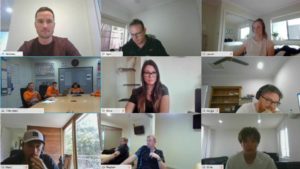
Some of the teams on BHP mine sites require specialised equipment and computer programs to carry out their work but they are often too large and complex to work on conventional laptops, which is what previously made remote working so difficult. In March 2020, the company’s Resource Engineering team launched the Technical Computing Environment (TCE) project to make some of these programs available off site. The TCE hosts these essential programs in an online data centre that the teams can access remotely, and, the company says, it’s been a game changer for the mine scheduling teams across its Queensland Coal business. The team has set up their home offices, which include large monitors and ergonomic work stations as most of the design work they do requires a large monitor to fit the design work on.
Planning for change
The next big question is: have the measures slowed down operations to the extent of having any effect on efficiency or productivity? The miner argument seems to be no as they have been planned for; but if you plan for a changed operation and that includes any operational effects as part of the planning, it has still had an impact.
Beringer said Barrick had factored all delays and other effects into their planning and these have had no material impact on operations.
Vale says that there has been no “material impact” on production so far. Its iron ore production guidance, as announced in its Q1 production and sales report, remains unchanged, in the range between 310-330 Mt for 2020. The company added that the impact of the COVID-19 pandemic on its operations is under control.
That said, as the journey against COVID-19 is expected to be a long one, the company has already factored in a possible guidance miss.
“All the risks that Vale anticipated are being managed as planned,” the company told IM.
The pandemic did influence the guidance it has been giving to the market though. Vale recently revised its guidance for iron ore fines production in 2020 to 310-330 Mt, from 340-355 Mt. “There are several reasons for the revision, including additional impacts related to the pandemic, associated with the risk of increasing absenteeism when running different sensitivity scenarios. The pandemic alone is responsible for the withdrawal of 15 Mt from the guidance.”
Anglo American says it has taken its planning to a different level and is very pleased with the strong productivity it is seeing. “At our Minas-Rio iron ore operation in Brazil, for example, we have all the appropriate measures in place and continue to operate at normal production levels. Our approach continues to be very comprehensive and demonstrates that safe work is productive work.”
Planning also extends to supporting the workforce. Newmont committed to paying all employees through to the end of June whether or not they were able to work. The company said its financial strength provides the flexibility to continue supporting its more than 15,000 employees, not only as a way to support workers and host communities, but also to position the company to maintain and ramp up operations further once the worst has passed.
Newmont also established a $20 million fund to help host communities, governments and employees combat the COVID-19 pandemic. The Newmont Global Community Support Fund builds upon other local contributions and efforts the company has implemented since March. This includes partnering with local governments, medical institutions, charities and non-governmental organisations to target funds towards addressing the greatest needs with a view to serving as a catalyst for long-term resiliency and future community development. To ensure that the fund supports communities in a robust and meaningful way, Newmont says it has worked diligently with local governments to design a plan focused on three key areas to ensure that the support is most impactful, namely: employee and community health, food security and local economic resilience.
Overall, from an operational point of view, it is likely that it will take some time to judge the true impact of the virus beyond the obvious effect of mandated slowdowns and shutdowns in terms of what effect it has had on costs and actual production.
The autonomy and digital new normal was already here
Now to dispel the myth that COVID-19 has somehow caused miners to have a sudden realisation that they need to automate or go digital. Mines have been implementing these measures to ensure greater efficiency for a number of years now, particularly in the wake of the financial crisis. It is worth remembering that Rio Tinto’s Mine of the Future program began as far back as 2008, as an example; which also happens to be the same year that Codelco was the first global miner to start commercially operating autonomous haul trucks, namely 11 Komatsu 930E-4 units equipped with the Komatsu FrontRunner AHS system, at its Gaby copper mine in Chile; though the system had actually been tested at Codelco’s Radomiro Tomic mine since late 2005.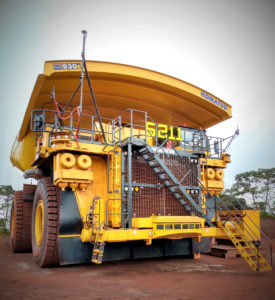
The feeling is that progress in technology continues despite the pandemic, not because of it.
Barrick says most of what it has achieved with digitalisation and automation was already in place before the pandemic. However, other digital technology, like e-learning etc, has been fast-tracked and will form part of the overall training packages it offers going forward. Newmont similarly said that technology and innovation programs were already underway.
The mentioned training effect is a good area to home in on. The global leader in digital simulators for mining equipment operator training, Immersive Technologies, recently launched a Remote Trainer Station , which combines remote control and video conferencing functionality between the simulator cabin and a trainer desk located in a separate space. In addition to live video and audio, the trainer is equipped with behaviour monitoring visualisations and simulator controls, which allows them to continue coaching as if they were right next to the trainee.
Anglo American, meanwhile, says it has made a further step-change to the planning required for world-class industrial operations during the pandemic.
“Our operating model and our performance optimisation program underpin our ability to perform consistently and with greater levels of confidence. Our FutureSmart Mining™ technology development and digitalisation program is designed to change the trajectory of mining; this work continues to change the way we operate and benefit both environment and society. We continue to make significant progress, despite the pandemic.
“We have full-scale implementations of our Coarse Particle Recovery technology underway at our Los Bronces and Mogalakwena operations. Our Bulk Ore Sorters are now in three of our operations, and we are currently further scaling the technology and its potential at Mogalakwena and Los Bronces. The hydrogen truck we announced last year is in development and progressing well towards trial at Mogalakwena. We are preparing to run two full-scale demonstrations in the next year of our hydraulic dry stacking technology, which engineers tailings facilities to rapidly de-water in weeks and leave dry, safe, stable land that can be repurposed for economic or community benefit. We are implementing integrated digital tools for planning, simulation, execution, and monitoring across the core of our value chain, from resource definition to the output of the plant. As recently as March, we launched a processing product from our proprietary data analytics suite, into our Moranbah met coal operation, which is already proving its value. If anything, the COVID-19 pandemic has presented a unique opportunity for us to make a further step-change in our innovation and do things very differently, to build back better.”
COVID-19 has sped up certain existing programs at the miners’ operations – Suncor recently announced it was bringing forward the rollout of autonomy on a fleet of Komatsu 980E mining trucks at its Fort Hills oil sands operation, for example, to get the benefits sooner in the wake of the effect of the pandemic on oil prices.
There is also a valid argument that, in some respects, mining is now seeing the reality of the value of the digitalisation steps that were already underway or in place.
In a recent article entitled Is COVID-19 digital’s moment to prove its value in mining? FLSmidth CEO, Thomas Schulz, said: “COVID-19 has shone a spotlight on just how important digital solutions and data analytics are for mining. When logistics are severely challenged, when it becomes difficult or even impossible to be on site, suddenly all the value of digitalisation becomes crystal clear…given current priorities, it is the advantages of remotely-controlled operations and predictive maintenance that will be most recognised and appreciated. In coronavirus-times, digitalisation is really the key that brings us closer to our customers (at a safe distance, of course!). But it also brings essential, actionable data close to hand and, perhaps, it even brings the expectation and reality of the optimised digital experience still closer together.”
Vale has been investing in digitalisation since 2016. In 2018, it launched a digital transformation program aiming to become one of the safest and reliable mining companies, focusing on people and on generating a positive impact. Many of the innovations put in place during the COVID-19 pandemic were already being implemented at the company’s operations. “The biggest impact of the pandemic was to accelerate these projects and make them available for the whole company in a short period of time. One example is an app designed to track people’s locations in the operational sites. It was being developed since last year and, in less than two months, it became available for all employees. Once an employee is diagnosed with COVID-19, it is possible through the app to know where he or she has been and trace every person that he or she got in contact with.”
What about suppliers and contractors?
Here there really is a new normal as many external equipment, technology and maintenance suppliers and contractors can no longer get any access to site. This has meant a fundamental change in how some parts of the non-owner-operator part of the mining business has had to function. Of course, where there are major contract miners actually doing the development and mining, this is largely unaffected as for all intents and purposes they are running their parts of the operation in place of the mine owner. But there are many other examples of METS companies that have had to adapt quickly.
Komatsu-owned MineWare has been ramping up its remote deployment offering with local teams recently helping a major copper mine in Chile set up its Argus monitoring system on five of its electric rope shovels without stepping foot on site. The company says calibrating multiple systems, for the first time virtually, was a historic achievement, made possible by the collective efforts of its remote teams working in close partnership with customer teams in the field.
Thyssen Schachtbau and Siemens remotely commissioned a new mining hoist recently at Uralkali’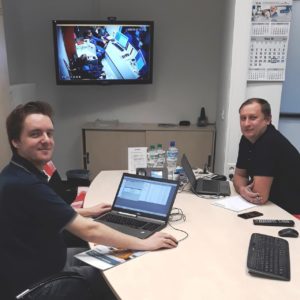 s Solikamsk-2 potash mine in Berezniki, Russia, from offices in Germany over 4,000 km away. A Siemens operations manager working in Thyssen’s office Mülheim was connected to the winder room online, watching the machinist via webcam and giving instructions on how to proceed. This online connection was originally intended only for fault localisation and remediation.
s Solikamsk-2 potash mine in Berezniki, Russia, from offices in Germany over 4,000 km away. A Siemens operations manager working in Thyssen’s office Mülheim was connected to the winder room online, watching the machinist via webcam and giving instructions on how to proceed. This online connection was originally intended only for fault localisation and remediation.
FLSmidth gave another example, where a team of field engineers were evacuated due to COVID-19 just as a kiln was about to come online. The customer asked for assistance and FLSmidth was quickly able to establish a secure and direct online communication channel between its engineers and the customer, which allowed its Machine Control Specialists to connect remotely to the systems. CCTV was put in place to share information that couldn’t be accessed directly and, within days, FLSmidth was able to start the kiln remotely.
It even applies to mineral processing feasibility.
TOMRA Sorting Mining has brought ore sorting testing capabilities to its stay-at-home mining customers though the development of virtual testing facilities that enable them to take informed purchasing decisions for their processing plants, regardless of location. TOMRA’s temporary Virtual Demonstration and Test Solution will enable mining companies to test the sorting solutions on their samples without leaving their office. They will just need to book a session with their TOMRA sales representative and ship a sample of their minerals to the Test Center, in Wedel, Germany, which will conduct the test.
Tungsten West (for the Hemerdon tungsten-tin project in Devon, England) along with at least three other companies has seen their material tested in this way.
And there is a feeling that many of the new ways in which OEMs and METS companies are interacting with customers are here to stay. Simon Andrews, Managing Director at Sandvik Mining and Rock Technology Southern Africa, recently stated: “The COVID-19 lockdown is adding impetus to the adoption of technology in mining in a way that is likely to change the sector quite dramatically.” With its advanced mining automation and teleoperation systems, it is possible to monitor machines and optimise operations from any distance. Andrews says Sandvik has long promoted the merits of this technology, but it is not always simple to dislodge established practices in a conservative industry. COVID-19 has forced the issue where everyone is now working differently and has had to adopt new technology.
He emphasises that there will be no going back to normal when intensity of the COVID-19 pandemic eases. “We want to be part of that journey with our mining customers, as they enter a new era of mining. This will see technology, data management and remote operations become a way of life – making mines safer, more efficient and more sustainable.”
The way forward will be long and unpredictable
Like the rest of the world, there is a feeling in mining that, while these measures are officially temporary, this virus and any similar future pandemics that may come along, will require some of them to remain in place long term. Therefore, all the companies had no immediate plans to withdraw or relax any of the new procedures.
Barrick stated: “We will continue with the measures until our internal systems and Trigger Action Response Plans allow for this. Any relaxation of these controls will also be done in consultation with our host communities and the relevant authorities. The situation will be assessed on a site-by-site basis. Some of these measures were already in place in Africa, particularly for Ebola in the DRC and West Africa years ago. We believe that good personal hygiene is not negotiable and we encouraged this before the COVID-19 pandemic.”
Newmont says most of the new procedures are envisioned to be phased out at some point but only once the risk of transmission has been eliminated and after consultation with health professionals. It clarified there had been no relaxation to date and none was planned. It will continue to utilise protective measures for its workforce and neighbouring communities, including screening, physical distancing, deep cleaning, and avoiding exposure for at-risk individuals. If at any point the company determines that continuing operations pose an increased risk to the workforce or host communities, it said it will reduce operational activities up to and including care and maintenance and management of critical environmental systems.
Anglo American had this to say: “Our WeCare programme has strong behaviour change elements; these will serve to reinforce the steps we all need to take to prevent COVID-19 and other diseases and to better manage our health and wellbeing. Such behaviours will not stop when the COVID-19 pandemic ends.”
Vale said it has no provisions for relaxing any of the measures adopted to prevent and tackle the new coronavirus in its operations. It adds: “It is not possible yet to say when the company is going back to normal or even how will this new normal be. But we are certain that many changes that were adopted during the pandemic will continue, such as the home office regime. It was formally introduced in the company last year, but as soon as the pandemic struck it became mandatory for all administrative personnel. In the future, Vale is envisioning a mixture of on-site and remote work.”
So it is fair to say that there is very much a new normal in mining, but it is one that is focused on worker safety and all the practicalities that come with that in terms of procedures, suppliers and contractors. There has been no big realisation moment that autonomy and digital have to be implemented right now due to COVID-19 – they were already in place or in development and, in many cases, were already bringing benefits; but, yes, there is more of a focus on these wins now and how new technology can be more effectively used in changing circumstances. Production wise, as COVID-19 has been factored into projected figures (beyond just accounting for temporary shutdowns), it has had an impact, but relatively minor. Should COVID-19 disappear completely or be brought under more or less total control with an effective vaccine, then many of the measures may be quickly lifted, but for now the mood is one of caution and taking small steps.
Lastly, a final angle on this is to look at the positives that have come out of it in operational terms. Rio Tinto’s Chief Executive J-S Jacques stated at the Bank of America Global Metals, Mining and Steel conference in May: “There are some recent gains we want to lock in, to enable future performance, such as increased collaboration across the business and with partners; a closer partnership between commercial and the operations and greater regional and locally empowered decision-making.”
He added: “Rio managed to move all of its iron ore employees to different rosters in a week, where previously it may have taken up to a year. It screened 9,000 employees in a few weeks through testing facilities at Perth airport which were set up from scratch, with the full support of the government both at the Federal and State levels. And it has managed to maintain business as usual across 36 countries despite a significant portion of our workforce working from home.”
J-S Jacques believes that this rapid response to changing conditions may become the norm. “These changes have enabled us to adapt quickly. And in a world where capital may be scarce, and the tolerance for risk lower, we want to maintain these characteristics to unlock new sources of growth, financing and market opportunities.”
Por Paul Moore
Fonte: International Mining





